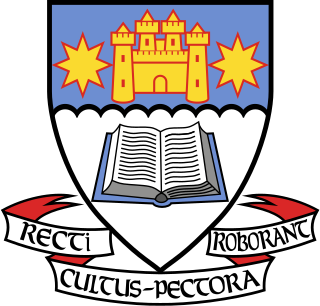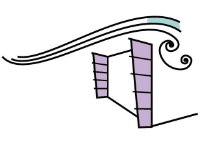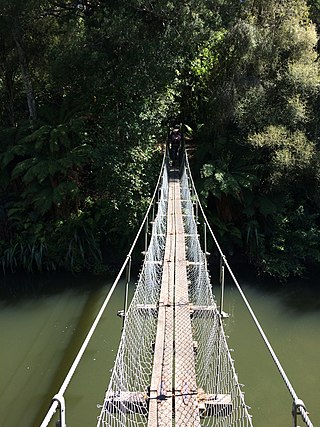
The national parks of New Zealand are protected natural areas administered by the Department of Conservation (DOC). The first national parks established in the country were all focused on mountain scenery. Since the 1980s the focus has been on developing a more diverse representation of New Zealand landscapes. The parks are all culturally significant and many also contain historic features. Tongariro National Park is one of the World Heritage Sites that are of both cultural and natural significance, while four of the South Island national parks form Te Wahipounamu, another World Heritage Site. There are currently 13 national parks; a 14th, Te Urewera National Park, was disestablished in 2014.

Founded in 1869, Auckland Grammar School is a state, day and boarding secondary school for boys in Epsom, Auckland, New Zealand.

Arrowtown is a historic gold mining town in the Otago region of the South Island of New Zealand. Arrowtown is located on the banks of the Arrow River approximately 7.5 km from State Highway 6. Arrowtown is located 19.5 kilometres to the east of Queenstown. As well as the route via State Highway 6 at Arrow Junction, there is also road access directly to Queenstown via Arthurs Point and a third route via the picturesque Lake Hayes.

Hanmer Springs is a small town in the Canterbury region of the South Island of New Zealand. The Māori name for Hanmer Springs is Te Whakatakanga o te Ngārahu o te ahi a Tamatea, which means “where the ashes of Tamate’s (sic) fire lay”, referring to Tamatea, the captain of the canoe Tākitimu.

Otago Boys' High School (OBHS) is a secondary school in Dunedin, New Zealand. It is one of New Zealand's oldest boys' secondary schools. Originally known as Dunedin High School, it was founded on 3 August 1863 and moved to its present site in 1885. The main building was designed by Robert Lawson and is regarded as one of the finest Gothic revival structures in the country. Situated on high ground above central Dunedin it commands excellent views of the city and is a prominent landmark.

Ōwhango is a small town in New Zealand situated about 20 kilometres (12 mi) south of Taumarunui on State Highway 4 (SH4), and about 2 kilometres (1.2 mi) west of the Whakapapa River, a tributary of the nascent Whanganui River.

Protected areas of New Zealand are areas that are in some way protected to preserve their environmental, scientific, scenic, historical, cultural or recreational value. There are about 10,000 protected areas, covering about a third of the country. The method and aims of protection vary according to the importance of the resource and whether it is publicly or privately owned.

Westmere is a residential suburb of Auckland, in northern New Zealand. The Auckland Council provides local governance. On the southern shore of the Waitematā Harbour, this former peninsula is by road about 6 kilometres (4 mi) west of the city centre.

Mount Albert Grammar School, commonly known as MAGS, is a co-educational state secondary school in Mount Albert in Auckland, New Zealand. It teaches students in year levels 9 to 13. As of August 2021, Mount Albert Grammar School is the second largest school in New Zealand, behind Rangitoto College.

Thorndon School is a New Zealand primary and intermediate school located in the suburb of Thorndon, Wellington, New Zealand.

Hamilton East is a suburb in central Hamilton in New Zealand. The suburb's primary commercial and retail precinct is located along Grey Street. Hamilton East is characterised by villas and bungalows built early in the 20th century.

Whataroa is a small township in southern Westland on the West Coast of New Zealand's South Island. It is located on alluvial flats to the west of the Whataroa River. State Highway 6 passes through Whataroa on its route from Ross to Franz Josef / Waiau. Hari Hari is 31 kilometres (19 mi) to the north-east, and Franz Josef is 32 km to the south-west.
Ilkeston Grammar School was a selective co-educational secondary school, admission being dependent on passing the 11-plus examination. It stood on King George Avenue, Ilkeston, in the south east of Derbyshire in the East Midlands of England.
Napier Girls' High School is a state secondary school on Clyde Road, Napier, New Zealand. It is one of the oldest schools in New Zealand for girls, and has a current school roll of about 1000.
Fairfield is an eastern suburb of Lower Hutt, in the Wellington Region of New Zealand.

Mataroa is a settlement in the Rangitikei District and Manawatū-Whanganui region of New Zealand's North Island.
Rangiotu is a farming community in the Manawatū District and Manawatū-Whanganui region in New Zealand's central North Island.
Ballance is a farming community in Tararua District and Manawatū-Whanganui region of New Zealand's North Island. The main settlement is located on the west back of the Mangahao River, south and west of Woodville and 11 km north-west of Pahiatua.

Henry Thomas Mandeno was a New Zealand modernist architect.

Glenfern Sanctuary Regional Park is a regional park situated near Port Fitzroy on Great Barrier Island in New Zealand's Hauraki Gulf.


















